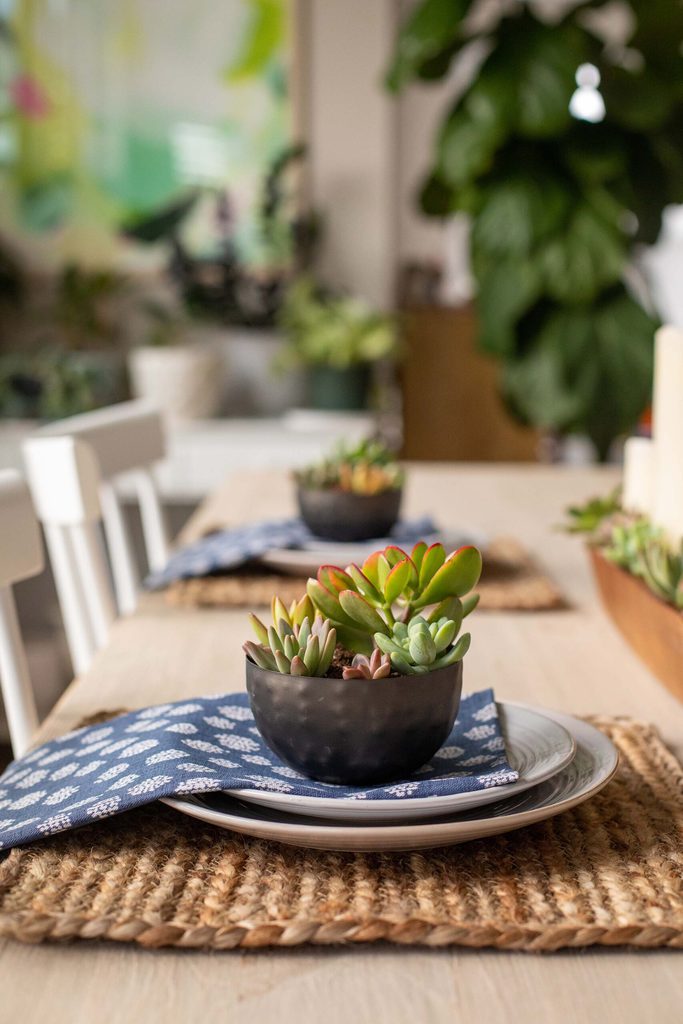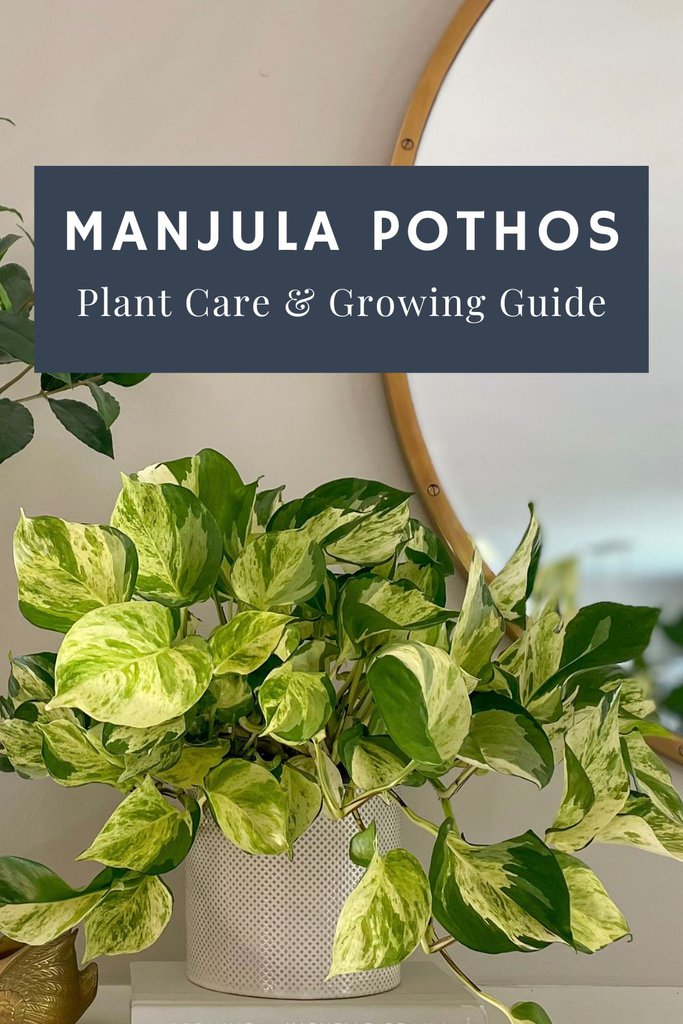Ficus Audrey Care Guide
Ficus Audrey is a lesser-known alternative to other Ficus varieties, such as Fiddle Leaf Figs, Ficus Benjamina, and Ficus Elastica, which are often kept as houseplants. Ficus Audrey is distinguished by its unusual and velvety soft leaves. This guide provides an overview of how to maintain a Ficus Audrey as a houseplant.
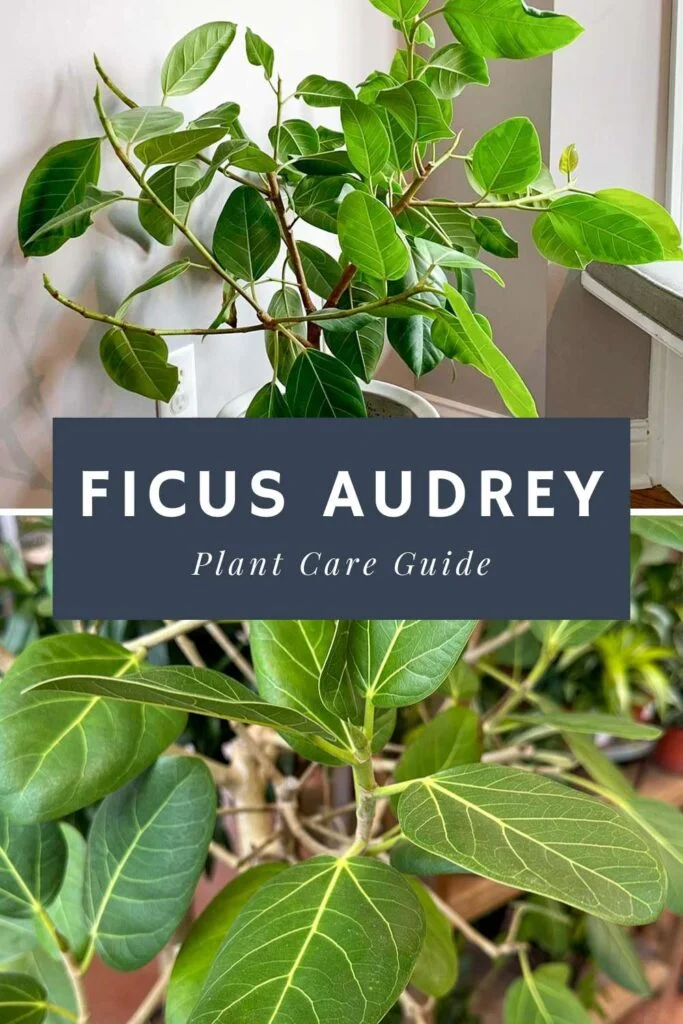
Origins of Ficus Audrey
This species is native to Pakistan and India. Ficus Audrey is notable as the national tree of India.
Some outdoor specimens have large aerial roots which allow the tree to grow to an incredible size.
The botanical name for is Ficus Benghalensis. The most popular common name for this plant is the banyan tree.
Ficus Audrey Appearance
The most distinctive feature of Ficus Audrey is its especially soft and fuzzy emerald green leaves. The leaves are oblong with lime green veining, branching off a light colored trunk and stems.
The plant grows in similar size and manner to its cousin Ficus Elastica, commonly known as the rubber tree. When grown indoors as a houseplant, it can grow up to 5 to 10 feet in height and up to several feet in diameter.
The growth rate and size of the plant depend on how it is cared for; namely, the amount of light, water and fertilization it receives. If any of these factors are limited, then the plant’s growth will also slow down.
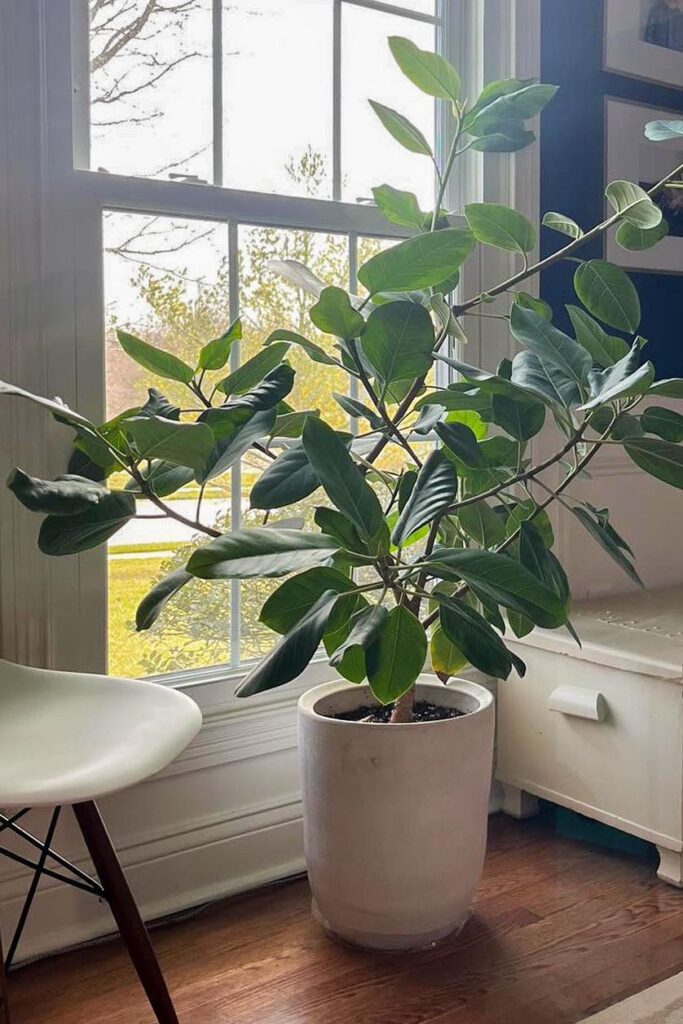
Ficus Audrey Care
As a member of the Ficus genus, Ficus Audrey falls somewhere between Fiddle Leaf Figs and Rubber Trees in its level of fussiness and care requirements. These are the specific conditions that are best for this houseplant:
Water
Water regularly and thoroughly when the soil is dry 1 to 3 inches below the surface. Allow the plant to completely dry out in between waterings but not for too long. Drooping leaves are a sign you have waited too long to water.
Always soak all of the plant’s soil thoroughly and allow water to drain out before returning to the cache pot or tray. This helps prevent pests and root rot.
Light
Ficus Audrey requires bright indirect light in order to grow. Lower light conditions may cause it to drop leaves.
This plant can be a slow grower in our darker Midwestern winters. An east-facing window is ideal. If you have a bright room with southern or western light exposure, that also works.
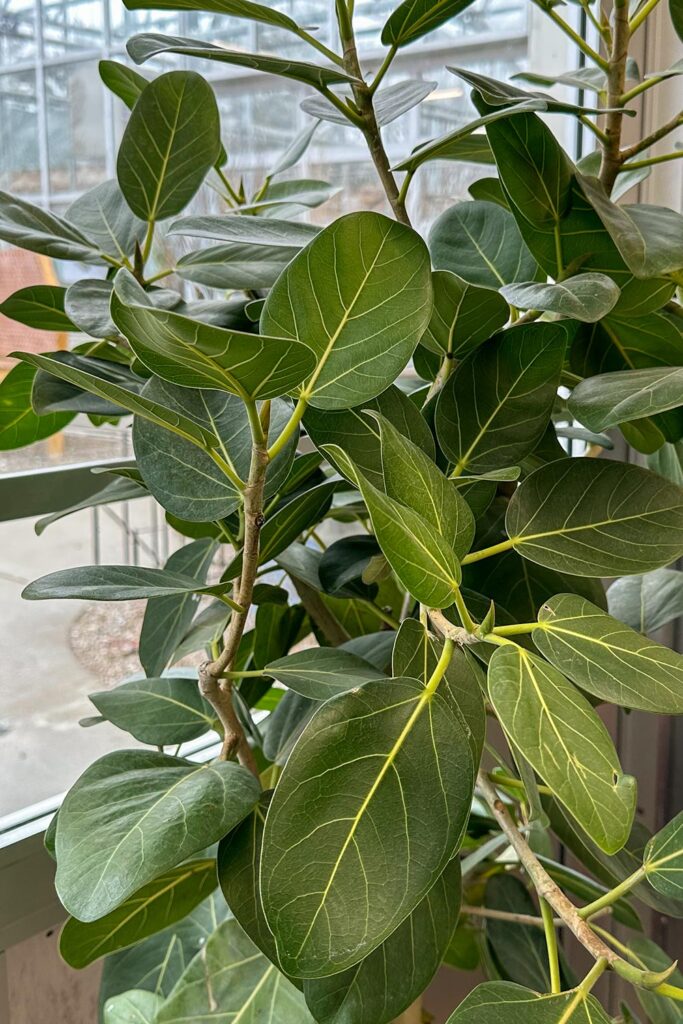
Soil
Similar to the Fiddle Leaf Fig, these plants grow best in even, well-draining soil. Any potting soil suitable for houseplants will do. There is always the option to amend the soil with chunky substrates like perlite or orchid bark to improve drainage.
Fertilizer
Mix earthworm casings into your houseplant soil mixture or sprinkle on top of houseplants that don’t need to be repotted. Costco usually has a great deal on a large bag at the beginning of the gardening season.
Another easy way to fertilize is with a liquid fertilizer specifically for houseplants. Make sure to follow the directions because using too much or fertilizing too often will stress your plant.
Fertilize regularly according to the product directions to encourage the plant to grow more quickly.
You can fertilize monthly starting in the late spring through the summer when growth is higher, and once every two months during the fall and winter months.
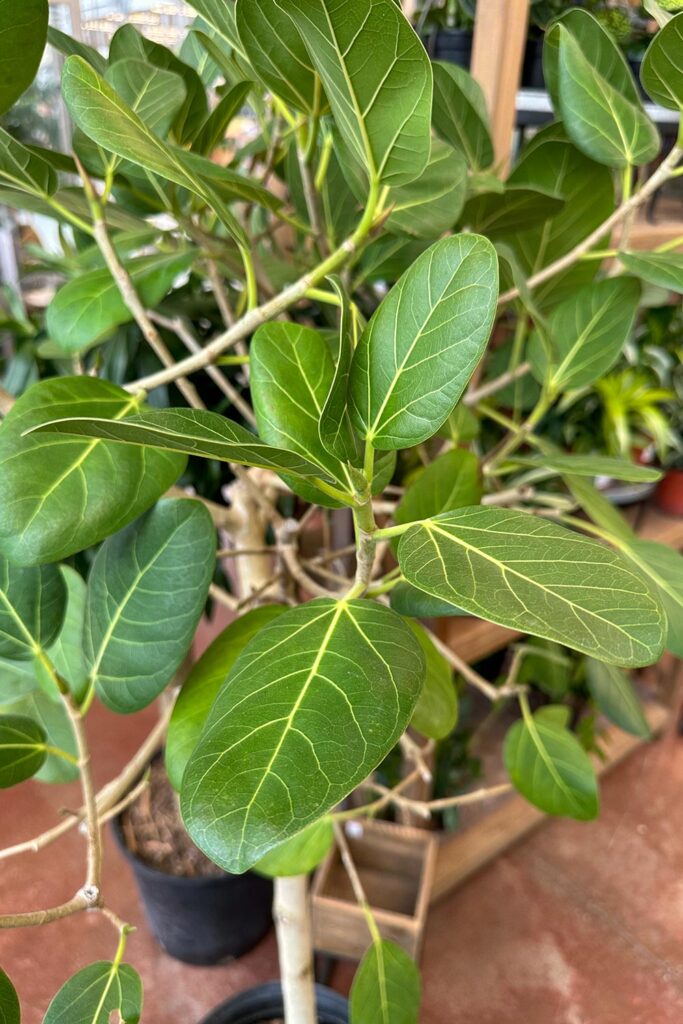
Temperature
A warm environment with minimal drafts is needed. A cold draft or sudden change in temperature can cause it to drop leaves.
Ideally, keep in a range of 60 to 70 degrees Fahrenheit.
Humidity
This plant enjoys a humid environment, so boosting humidity is helpful for this houseplant, especially during the winter. Placing plants together in groupings will increase air humidity around them. You can also use a humidifier, pebble tray, or mist plants occasionally.
Growth
With the right care and nutrients, this plant can grow quickly. Mine has not been a particularly fast grower. Only in the summer has it pushed out several new leaves all at once. Otherwise, the leaf buds seem to linger for ages before finally unfurling.
The plant will grow most quickly if it receives ideal light and watering conditions. Any reduction in light or water will also restrict its growth.
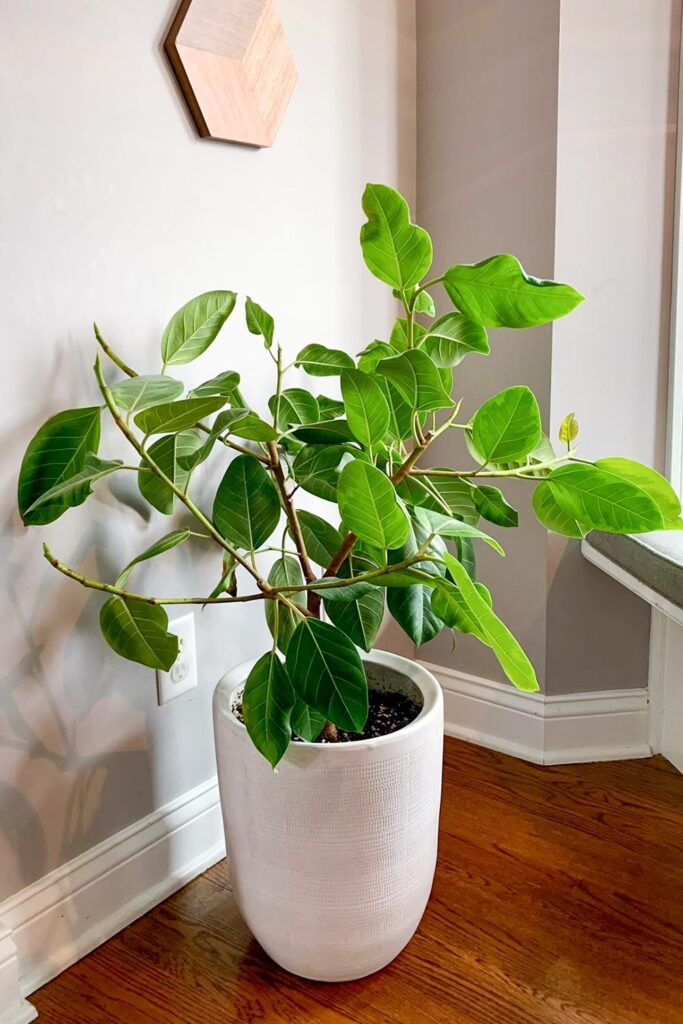
Pruning
Prune during the winter season when the plant growth is slow.
Use pruning to maintain your preferred shape and size for the plant. You can allow it to branch out widely or grow upright on one stem.
Wear gloves and use sharp garden shears or scissors to prune. **affiliate links**
Always cut above the node to encourage new growth and branching.
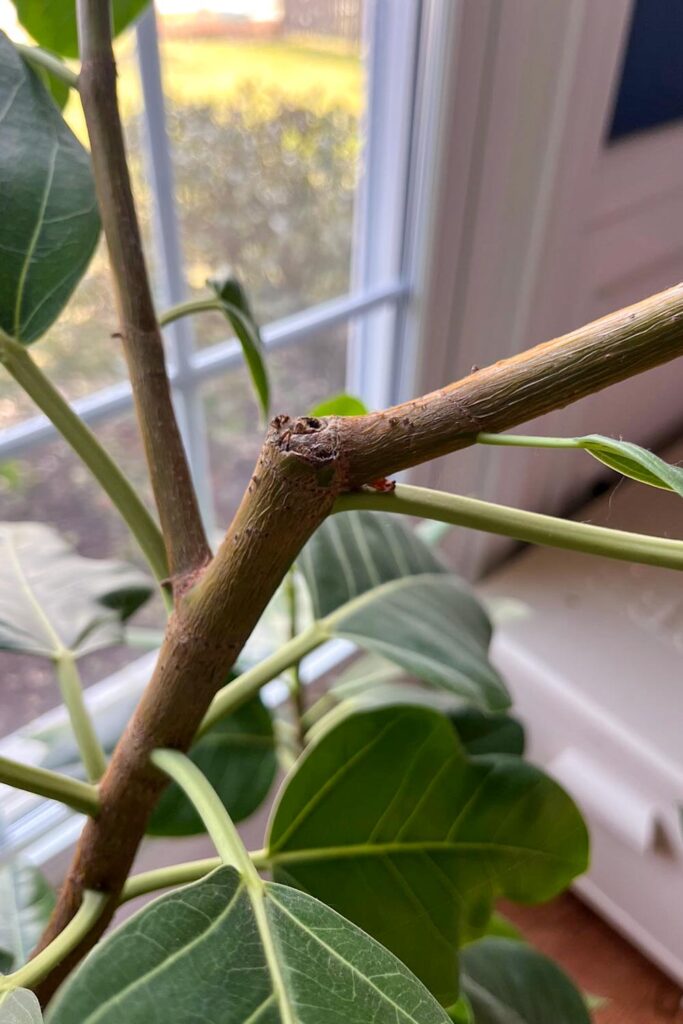
Repotting
Repotting will be necessary as the plant grows to avoid restriction of the roots in the pot (also known as being root bound). Consider repotting once a year depending on the amount of growth.
Always use a pot with drainage holes. A good rule of thumb is to increase the size of the pot by no more than 1 inch when repotting.
Common Problems with Ficus Audrey
Those beautiful fuzzy leaves will attract dust. Clean the leaves regularly to maintain the plant’s health and discourage pests. A soft, lint-free cloth and water are all you need to clean your houseplants.
Brown Leaves
Brown leaves are most likely a sign of low humidity. Mist the plant or set up a humidifier if your plant develops crispy brown edges on its leaves.
Yellow Leaves
Yellowing leaves can be a sign of pests or disease, but most likely due to over-watering to which this plant is susceptible.
Make sure the soil is completely drenched with water and then fully drains out. Do not allow this plant to sit in water or you will likely experience root rot in addition to yellowing leaves.
Drooping Leaves
Drooping leaves most likely indicates the plant is in need of water. Always check the soil before watering, but drooping leaves are a notable indicator.
Pests
This plant is susceptible to common pests such as spider mites, thrips, mealybugs, and scale.
Use Neem oil products or insecticidal soap to combat houseplant pests.
Comparing Ficus Audrey with Other Ficus
Ficus Audrey is known to be less fussy than other types of Ficus that are grown as houseplants.
Ficus Audrey vs Fiddle Leaf Fig
Some people feel Ficus Audrey is easier to care for and less finicky than the Fiddle Leaf Fig. The Fiddle Leaf Fig is more sensitive overall to environmental changes than Ficus Audrey. However, Ficus Audrey is prone to dropping leaves if exposed to a cold draft.
Water and light requirements are similar for these plants. Ficus Audrey might be a bit finicky about humidity requirements.
Ficus Audrey has much smaller leaves than the Fiddle Leaf Fig, and the leaves also have a completely different shape and appearance.
Ficus Audrey is an excellent houseplant to try if you are successfully growing a Fiddle Leaf Fig.
Ficus Audrey vs Altissima
Ficus Altissima is another variety of Ficus commonly grown as a houseplant. This plant has stunning yellow-green variegation on its leaves, which have a shiny appearance, unlike the fuzzy leaves of Ficus Audrey.
Ficus Audrey has lighter emerald green leaves with bright green veining. Although these Ficus varieties have very different leaf appearances, they do have similar care requirements.
Where to Buy
Ficus Audrey is growing in popularity especially among houseplant collectors. You may be able to find this plant at most local nurseries which sell houseplants. It will be more difficult to find in big box stores.
If local stores do not have it, you can easily order one online – anywhere from a 4” baby size to a miniature tree in a 14” pot or larger.
FAQ
Does Ficus Audrey purify the air?
Houseplants like this one help clean the air when they open their stomata at night to “breathe” in Co2 from indoor air.
Is Ficus Audrey rare?
Ficus Audrey is less common than the Fiddle Leaf Fig but is trending in popularity.
Does Ficus Audrey like to be misted?
Yes! Misting is a great way to supplement humidity for your plant. You can also set up a pebble tray, run a humidifier, or bring it into your shower.
Is Ficus Audrey poisonous?
Yes, it is toxic to pets and children if ingested.

